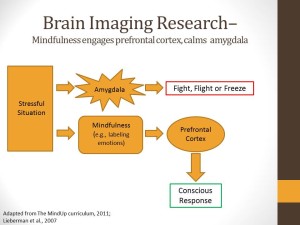Mindfulness in the Mercer Island Schools:
A Panel Discussion
Thursday, May 22, 2014
7-8:30 PM
Location: KCLS Mercer Island Library
4400 88th Ave SE
Mercer Island, WA 98040
Join us for a discussion of the teaching of Mindfulness in the Mercer Island Schools. Mindfulness has been in the news a lot, most recently on the cover of Time Magazine. Everyone from Google engineers to the Seahawks are now benefiting from these easy-to-learn techniques that promote creativity, focus, stress-reduction, and emotional self-regulation. We will discuss the pilot and ongoing programs in the Mercer Island School District; how mindfulness is taught to children and teens; what some of the initial reaction to and achievements of the MISD programs have been; and what we can do to support its further adoption in our school district. We will also discuss how parents can support the lessons their kids have been learning in the classroom and how mindfulness techniques can help parents too. Brief mindfulness practices you can do on your own will be shared as well.
Speakers include mindfulness instructors and facilitators active in the Mercer Island and Seattle schools: Janine Bloomfield, facilitator, Lynne Brazg, Arlen Levy, Brody LaRock, and Sivie Suckerman.
Facilitator and Panel Member Bios
Janine Bloomfield, PhD (Facilitator) teaches mindfulness at West Mercer Elementary in the Mercer Island School District using curriculum from Mindful Schools, MindUp, InnerKids, and experience from her own long-term practice. She is currently enrolled in the year-long Mindful Schools certification program. You can find out more about Janine and her program, along with parent resources and links, at her website, http://www.mindexplorekids.org. Janine is a mother of three, with two children currently attending Mercer Island public schools, and one recent graduate. She lives in Mercer Island.
Lynne Brazg, M.Ed (Counseling) has retired from school counseling and is a parent educator and coach. She has over 18 years of experience working with children and parents including women in transitional housing and parents of infants and tots through teens. She also has an advanced certificate in Infant Mental Health and is a trained group facilitator of Listening Mothers groups and Reflective Parenting groups affiliated with the Community of Mindful Parents. She is also a trained and certified lead trainer of Positive Discipline Parenting groups. Lynne has trained with Dr. Amy Saltzman in the Still Quiet Place Curriculum as well as with Mindful Schools. She has been facilitating parenting groups teaching mindful parenting and working in schools teaching mindfulness. Lynne is the mother of three young adults who have been her best teachers.
Brody LaRock, Ed.D. is the assistant principal at John Hay Elementary in Seattle. His doctoral research examined how educational leaders and K-12 schools nation-wide are integrating mindfulness education into their school settings. He has received several trainings including the mindfulness curriculum training from Mindful Schools and is currently taking another offered by MindUp. Brody is also enrolled in the UCLA Mindful Awareness Research Center’s Mindfulness Facilitation Certification Program. Brody lives with his loving and amazing wife and two never-a-dull-moment daughters in the Central District of Seattle.
Arlen Levy MA (Special Education, Communicative Disorders) has recently retired from 30 years of teaching in public and private schools at both the middle and high school levels. She was the Middle School Learning Specialist at the Jewish Day School in Bellevue for the past 17 years when she retired last July. She has trained with Amy Saltzman in the Still Quiet Place curriculum and completed the curriculum training in Mindful Schools. She has been an active participant with the Center for Child and Family Well Being at the University of Washington, taking trainings from Susan Kaiser Greenland (Inner Kids) and Kristen Neff, a researcher in the field of compassion training. Arlen has been teaching mindfulness to teens in Seattle public schools, and CREST high school on Mercer Island this past school year. She loves working with ‘tweens and teens, who often teach her as much as she teaches them. The mother of two young adult children living in Los Angeles, Arlen lives in Bellevue with her husband and 2 dogs.
Sivie Suckerman, MA, LMHC, CMHS has a Master’s Degree in Clinical Psychology from The Chicago School of Professional Psychology and has been practicing as a Licensed Mental Health Counselor since 2007. Sivie has worked in outpatient mental health, women’s health, school-based mental health, residential settings, and as the Clinical Supervisor for King County’s Children’s Crisis Outreach Response System. Currently, Sivie works for MIYFS and counsels students at Island Park Elementary as well as bringing the Mindful Schools curriculum into the classrooms. Sivie also has a small private practice in Bellevue where she utilizes mindfulness in group format as well as individually with children, teens, and adults.


